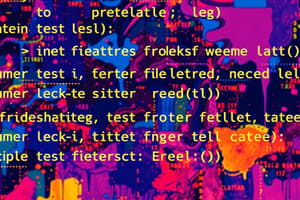Podcast
Questions and Answers
If the ball is dropped from a height of 64 cm, what will be its height after the first bounce?
If the ball is dropped from a height of 64 cm, what will be its height after the first bounce?
- 32 cm (correct)
- 8 cm
- 16 cm
- 4 cm
When should the program stop printing the heights according to the given instructions?
When should the program stop printing the heights according to the given instructions?
- When the height reaches 0.1 cm
- When the height reaches 0.001 cm
- When the height reaches 0.01 cm
- When the height reaches 0.05 cm (correct)
What output format should be used for printing the heights?
What output format should be used for printing the heights?
- Fractional values
- Scientific notation
- Floating-point numbers (correct)
- Integer values
If the user inputs a value of 10 for n (number of times to bounce), how many heights will be printed in total?
If the user inputs a value of 10 for n (number of times to bounce), how many heights will be printed in total?
What is the purpose of the 'append' operation in Python lists?
What is the purpose of the 'append' operation in Python lists?
How is indexing done in Python lists?
How is indexing done in Python lists?
What does the 'extend' operation do in Python lists?
What does the 'extend' operation do in Python lists?
In Python lists, what does negative indexing allow you to do?
In Python lists, what does negative indexing allow you to do?
What does the 'insert' operation do in Python lists?
What does the 'insert' operation do in Python lists?
What is slicing used for in Python lists?
What is slicing used for in Python lists?
Flashcards are hidden until you start studying




